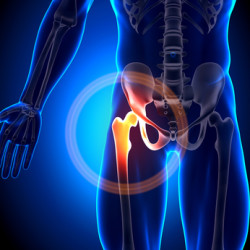Top Class Actions’s website and social media posts use affiliate links. If you make a purchase using such links, we may receive a commission, but it will not result in any additional charges to you. Please review our Affiliate Link Disclosure for more information.

The surgeon, physician and physical therapist have likely explained what to expect following artificial hip surgery —what activities to avoid and those to engage in to have the most favorable outcome possible.
Following hip replacement surgery, many have pain medications prescribed and some form of physical therapy for six weeks or so to help with joint and muscle recovery. The pain medication helps enable patients to move despite the pain so they could complete their exercises.
After three to six months, hip replacement patients usually undergo a follow-up exam. If there are no problems, they may be able to return to work and resume many of their normal activities. But what if a patient continues to have pain after hip replacement surgery?
Pain After Hip Replacement
Most patients are told that they will regain mobility and have less pain once an artificial hip is implanted. This is not always the case, however, as some patients continue to suffer after hip replacement surgery. What might be the cause?
Common issues that may contribute to pain following hip replacement surgery include infection at the site of the hip implant, wear and tear on the implant and joints over time, dislocation of the joint, and the joint causing a leg length discrepancy leading to pain from compensation.
Most of these sources of pain can be easily diagnosed and further treatment can help with the issues causing the pain. But what if the doctor has ruled out common causes and nothing shows up on imaging studies? In some cases, the hip implant itself is to blame.
Metal on Metal Artificial Hip
Most hip implants contain metal joints that mimic the body’s own ball-and-socket hip joint. However, many devices have a liner made from ceramic or plastic to keep the components from touching.
Metal on metal hip implants don’t have this lining, so the metal component parts touch. This can cause a number of different conditions that lead to pain and illness in the artificial hip recipient since the metal pieces may flake off of the implant when the artificial hip moves normally in the course of its job. Some of these conditions include:
- Body Rejection of the Implant: Since the metal particles are foreign to the body, an immune response to the particles is mounted, causing inflammation and resultant pain. The joint can also become loose, pop or even dislocate. Fluid can collect around the implant, and tissue may die.
- Metal Poisoning: High levels of cobalt and chromium in the implants may be seen in patients since the artificial hip is made of these materials. This metallosis (metal poisoning) can cause other issues like endocrine disorders, heart disease and organ failure.
- Tumors, psedotumors and cancer have also been reported as a result of metal hip implants.
Many patients with metal hip implant issues will have to undergo hip revision surgery which is considered to be harder on the body and requires additional recovery time.
Hip Replacement Surgery Lawsuit Information
Many patients who had a metal on metal hip implant placed and go on to have pain and other problems felt that they were not properly warned of the risks they were taking when they consented to hip replacement surgery.
A number of those who suffered complications after hip replacement surgery have decided to take legal action against the hip manufacturers for failing to provide adequate warning. These patients also often allege that the manufacturer sold a defectively designed product that was misrepresented. Almost all seek compensation for their pain and suffering.
Several manufacturers of metal on metal hip implants have been targeted, such as Biomet, DePuy Orthopaedics, Wright, and Stryker. Plaintiffs have successfully secured legal compensation for hundreds of thousands of dollars in compensation to help them cover their medical bills and for their pain and suffering.
If you have experienced problems as a result of a metal on metal hip replacement, an attorney can review your case in a complimentary consultation and can assist you in understanding your legal options.
Do YOU have a legal claim? Fill out the form on this page now for a free, immediate, and confidential case evaluation. The hip implant attorneys who work with Top Class Actions will contact you if you qualify to let you know if an individual lawsuit or class action lawsuit is best for you. [In general, metal hip implant lawsuits are filed individually by each plaintiff and are not class actions.] Hurry — statutes of limitations may apply.
ATTORNEY ADVERTISING
Top Class Actions is a Proud Member of the American Bar Association
LEGAL INFORMATION IS NOT LEGAL ADVICE
Top Class Actions Legal Statement
©2008 – 2024 Top Class Actions® LLC
Various Trademarks held by their respective owners
This website is not intended for viewing or usage by European Union citizens.
Get Help – It’s Free
Join a Free Metal Hip Replacement Class Action Lawsuit Investigation
If you or a loved one had a metal-on-metal hip implant that failed or caused serious complications, you may be entitled to compensation. Hip replacement lawsuits are being filed now against multiple companies, including Stryker, Biomet, DePuy, Zimmer, and Wright. See if you qualify to take legal action by filling out the form below.
An attorney will contact you if you qualify to discuss the details of your potential case at no charge to you.
Oops! We could not locate your form.












